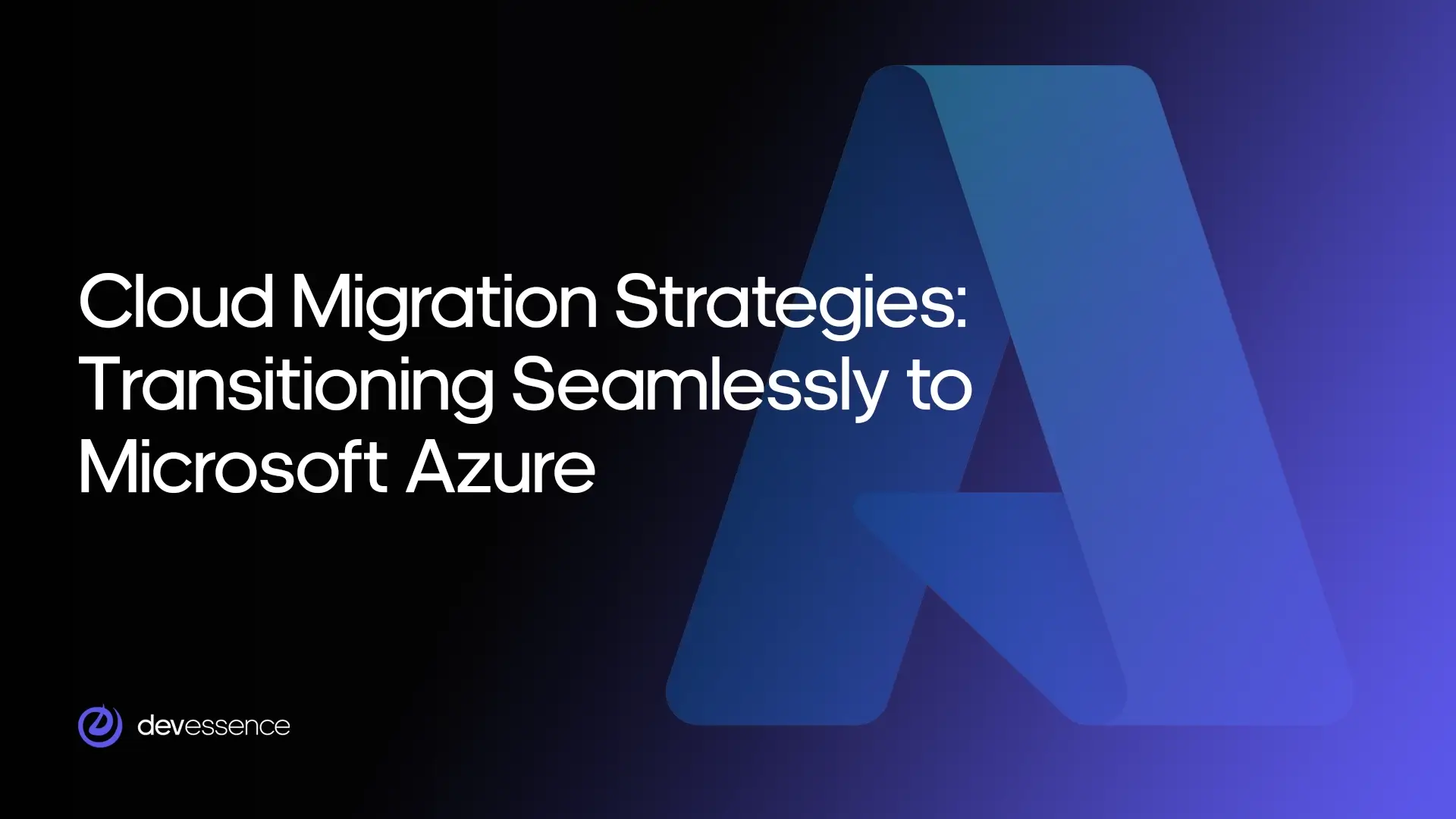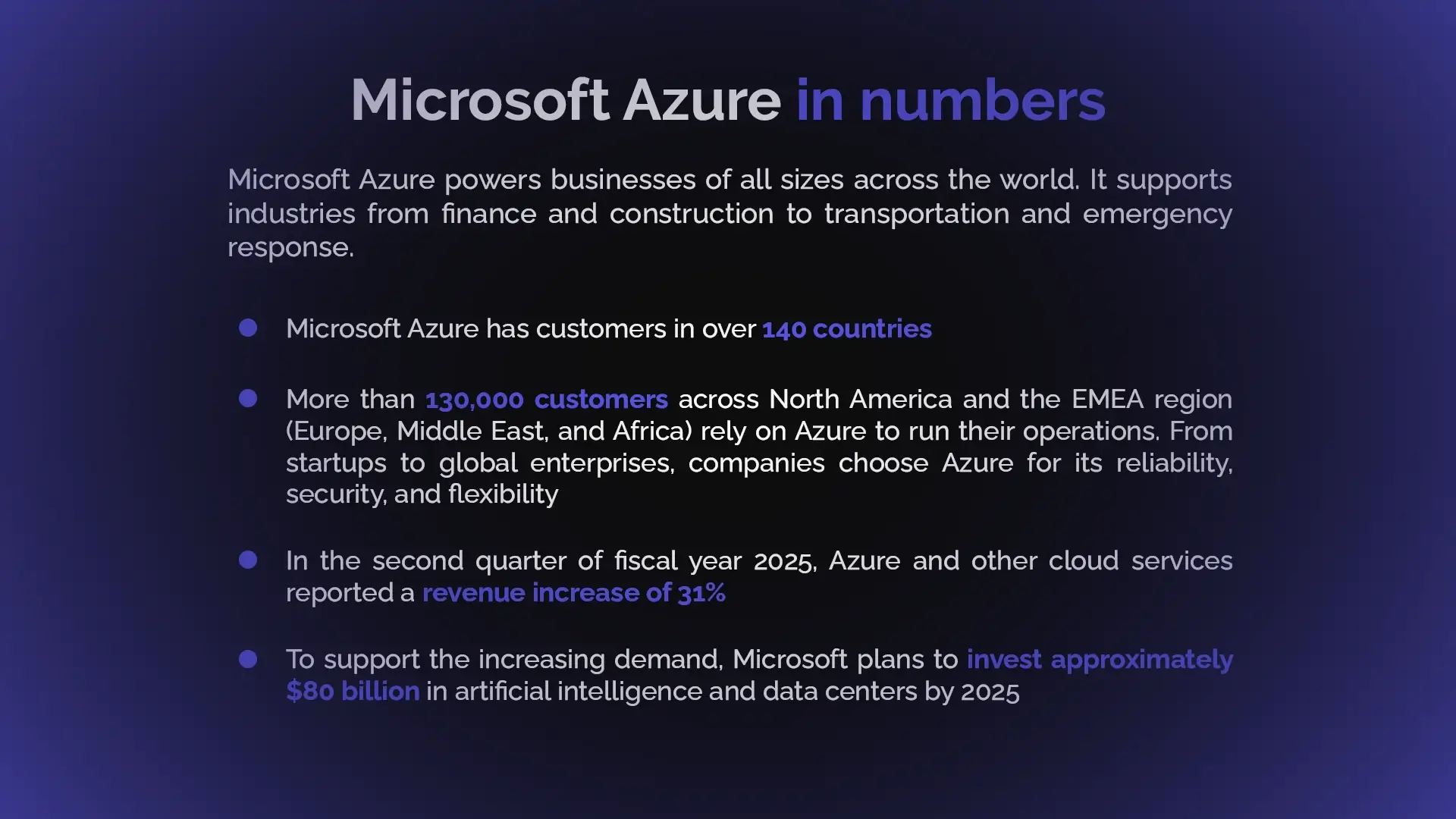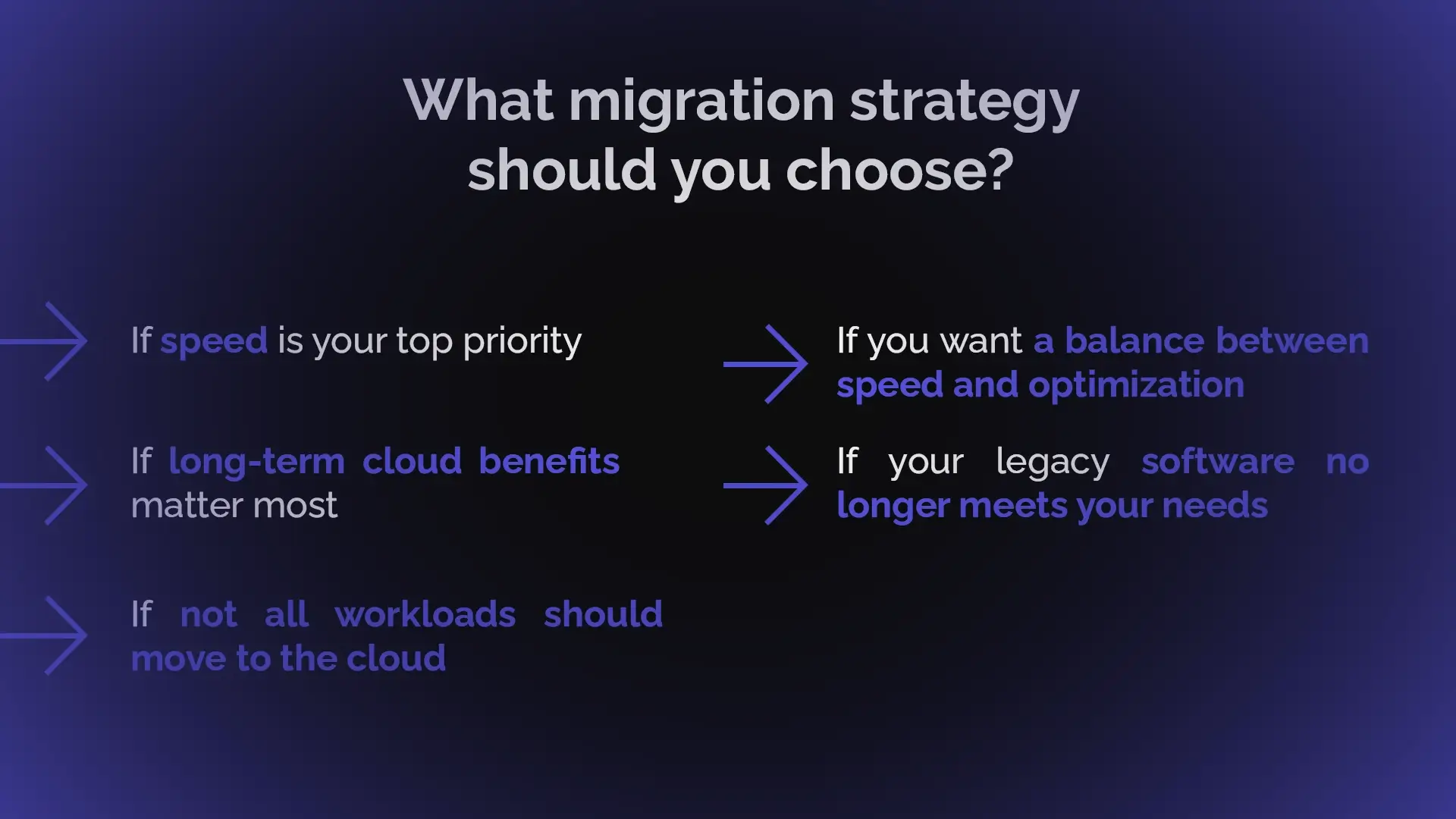
Besides being a significant tech upgrade, migrating to the cloud is the only way forward. With 70% of CIOs anticipating that more than half of their workloads will reside in the cloud by 2026, up from 45% today, staying on legacy systems isn’t just outdated; it’s a competitive risk.
Microsoft Azure has become the go-to choice for businesses aiming to future-proof their operations, offering scalability, AI-driven security, and seamless integration with existing infrastructures. Yet, a successful transition demands more than just moving workloads. It requires a strategic approach, risk mitigation, and precise cost control.
In this guide, we’ll try to uncover the smartest strategies for migrating to Microsoft Azure and help you sidestep common pitfalls while maximizing security, efficiency, and return on investment.
Why Microsoft Azure?
Choosing the right cloud platform is crucial for businesses looking to move faster, reduce costs, and stay secure. Microsoft Azure stands out by offering scalability, built-in security, seamless integration, and industry-leading AI and analytics capabilities.
Scale on demand, pay only for what you use
Azure’s global cloud infrastructure spans over 60 regions and more than 200 data centers, allowing businesses to scale up or down instantly. This elasticity ensures you always have the right amount of computing power without overspending. Azure’s pay-as-you-go model prevents unnecessary costs, while businesses with predictable workloads can save up to 72% with reserved instances.
Security and compliance you can trust
Azure provides multi-layered security powered by AI-driven threat detection. Microsoft invests over $1 billion annually in cybersecurity and employs more than 8,500 security experts to protect against evolving threats. The platform meets over 100 compliance certifications, including ISO 27001, HIPAA, GDPR, and FedRAMP, ensuring the highest data protection standards.
Seamless integration with your existing tools
Azure is designed to work with what you already use. It integrates effortlessly with Microsoft 365, Dynamics 365, and thousands of third-party applications, allowing businesses to migrate without disrupting workflows. Its hybrid cloud capabilities enable seamless connections between on-premises and cloud environments, offering the best of both worlds.
Built-in AI and analytics for smarter decision-making
Azure isn't just a cloud platform – it’s an AI-powered ecosystem. Businesses can leverage Azure OpenAI Service, Azure Machine Learning, and real-time analytics to gain insights, automate processes, and enhance decision-making. Companies using AI-driven cloud solutions have seen a 40% increase in operational efficiency and faster innovation cycles.
A commitment to sustainability
Azure is leading the charge in sustainable cloud computing, with Microsoft pledging to be carbon negative by 2030. Azure data centers run on 100% renewable energy, helping businesses reduce their carbon footprint while achieving digital transformation.
Ready to migrate? We are here to help you with a seamless transition to Azure
Contact usMicrosoft Azure in numbers

Microsoft Azure powers businesses of all sizes across the world. It supports industries from finance and construction to transportation and emergency response.
– Microsoft Azure has customers in over 140 countries.
– More than 130,000 customers across North America and the EMEA region (Europe, Middle East, and Africa) rely on Azure to run their operations. From startups to global enterprises, companies choose Azure for its reliability, security, and flexibility.
– In the second quarter of fiscal year 2025, Azure and other cloud services reported a revenue increase of 31%.
– To support the increasing demand, Microsoft plans to invest approximately $80 billion in artificial intelligence and data centers by 2025.
Supporting industries that keep the world running
Azure plays a critical role in industries that impact daily life:
– Construction: PCL Construction uses Azure to improve job site safety and efficiency.
– Emergency management: Beca relies on Azure Maps to support real-time disaster response.
– Transportation: Alaska’s Department of Transportation uses Azure analytics to provide accurate weather updates and keep roads safe.
– Aviation: Airmap helps manage drone airspace with Azure’s cloud technology.
Major corporations, including BMW, Banco Santander, and Shell plc, also run essential workloads on Azure, taking advantage of its global infrastructure and security.
Designed for businesses of all sizes
Azure serves organizations at every stage of growth:
– Growing mid-sized companies: Businesses expanding their cloud usage to improve efficiency.
– Established enterprises: Large companies integrating cloud services into their IT strategy.
– Small businesses and startups: Companies adopting flexible cloud solutions to scale as needed.
This is a perfect option for businesses wherever they are in the world.

Migration Strategies: Choosing the Right Approach
Every cloud migration is different. The best strategy depends on your business goals, the complexity of your applications, and your budget. Choosing the right approach can mean the difference between a smooth transition and unexpected challenges.
Lift and shift for a fast move
For organizations looking to migrate quickly, the lift-and-shift (rehost) approach offers the fastest path. This method moves applications and workloads to Azure with minimal changes. It’s ideal for businesses that need to move now and optimize later.
Pros:
– Speed: One of the fastest ways to migrate applications to Azure.
– Minimal disruption: No need for extensive code modifications.
– Lower upfront costs: Reduces migration complexity and allows businesses to start using cloud infrastructure quickly.
Cons:
– Limited cloud benefits: Applications don’t take full advantage of Azure’s cloud-native capabilities.
– Potential inefficiencies: Legacy applications may not be optimized for cloud performance, leading to higher costs over time.
– Security and compliance challenges: Existing security configurations may not align with cloud best practices.
Replatforming for better efficiency
A step beyond lift-and-shift, replatforming (refactoring) makes minor modifications to applications to improve performance on Azure while keeping core functionality intact. This approach balances speed with optimization, offering better efficiency without the heavy costs of a full redesign.
Pros:
– Better performance: Minor modifications help applications take advantage of Azure’s scalability.
– Cost efficiency: More optimized workloads result in better resource utilization and lower operational expenses.
– Less disruption: Requires fewer code changes than rearchitecting, making migration smoother.
Cons:
– Still not fully cloud-native: While optimized, applications may not fully leverage Azure’s automation and advanced features.
– Requires development effort: Even minor modifications demand development resources, increasing migration complexity.
Rearchitecting for cloud-native transformation
For businesses ready to embrace the full power of the cloud, rearchitecting is the most transformative option. Applications are redesigned to be cloud-native, unlocking Azure’s scalability, automation, and resilience. This approach requires more investment upfront but delivers the highest long-term benefits.
Pros:
– Full cloud benefits: Applications become scalable, resilient, and highly available.
– Cost savings over time: Optimized workloads lead to lower operational costs in the long run.
– Better security and compliance: Cloud-native architectures integrate Azure’s advanced security features more effectively.
Cons:
– High initial investment: Requires significant development time and resources.
– Complex migration process: Demands in-depth reengineering and rigorous testing before deployment.
– Potential business disruption: Long migration timelines may impact business operations.
Replacing legacy systems with modern SaaS solutions
Some companies may choose to replace legacy applications entirely with software-as-a-service (SaaS) solutions. Instead of maintaining outdated software, businesses can switch to cloud-based tools that offer better scalability, security, and performance – all while reducing operational overhead.
Pros:
– Reduced maintenance: SaaS providers handle updates, security, and performance optimizations.
– Faster implementation: Deploying a SaaS solution is often quicker than rearchitecting an entire system.
– Lower IT costs: No need to maintain or upgrade on-premises infrastructure.
Cons:
– Limited customization: SaaS solutions may not offer the same flexibility as custom-built applications.
– Vendor lock-in: Businesses rely on third-party providers for features, security, and updates.
– Data migration challenges: Moving data from legacy systems to a SaaS platform requires careful planning.
Retaining and retiring workloads strategically
Not every workload belongs in the cloud. Some applications may need to stay on-premises due to compliance, latency, or operational constraints, while others may be outdated and no longer necessary. Evaluating which workloads to retain and which to retire ensures a streamlined, cost-effective cloud strategy.
Pros:
– Cost control: Retiring unnecessary applications reduces expenses.
– Better compliance: Keeping sensitive workloads on-premises ensures regulatory adherence.
– Hybrid flexibility: Businesses can maintain a hybrid approach, using both on-premises and cloud resources as needed.
Cons:
– Ongoing maintenance costs: Retained workloads require infrastructure and IT resources.
– Integration challenges: On-premises systems may require additional effort to connect with cloud-based applications.
– Missed cloud benefits: Retaining workloads prevents businesses from taking full advantage of Azure’s automation and scalability.
What migration strategy should you choose?

The right migration strategy depends on your business priorities, application complexity, and budget. Here’s how to decide which approach best fits your needs:
If speed is your top priority
Choose lift-and-shift if you need to migrate quickly with minimal disruption. This is ideal for businesses that want to move first and optimize later. However, be prepared for potential inefficiencies and higher long-term costs.
If you want a balance between speed and optimization
Opt for re-platforming if you’re looking for better efficiency without the complexity of a full redesign. This works well for companies that need improved performance and cost savings but aren’t ready for a complete transformation.
If long-term cloud benefits matter most
Go with rearchitecting if you want to fully embrace cloud-native capabilities. This is the best option for companies investing in scalability, automation, and resilience. While the upfront effort is significant, the long-term cost savings and performance gains make it worthwhile.
If your legacy software no longer meets your needs
Consider replacing outdated systems with SaaS solutions. This is a great fit for companies looking to modernize operations quickly while reducing IT overhead. However, ensure the SaaS platform you choose meets your business’s customization and compliance needs.
If not all workloads should move to the cloud
A retain and retire strategy is ideal for organizations that need to keep certain workloads on-premises due to compliance, latency, or business constraints. This approach helps streamline costs by phasing out outdated applications while keeping essential workloads operational.
Making the right decision
Many businesses adopt a hybrid approach, combining multiple strategies to balance speed, cost, and optimization. A structured assessment of your IT environment, using tools like Azure Migrate and Azure’s cost management tools, can help determine the best strategy for each workload.
Regardless of your approach, a well-planned migration ensures security, cost control, and long-term business success. Need expert guidance? Devessence can help you craft a tailored Azure migration strategy that aligns with your goals.
A Step-by-Step Approach to a Secure and Cost-Effective Migration
Migrating to Microsoft Azure is a strategic move that impacts security, costs, and overall business operations. A well-planned, step-by-step approach helps organizations transition smoothly, minimize disruptions, and unlock the full potential of the cloud.
Step 1: Assess and plan for a seamless migration
A successful migration starts with a comprehensive assessment of your current IT environment. This phase identifies which applications, workloads, and databases should be migrated, optimized, or retired.
- Workload analysis. Evaluate your IT infrastructure to determine which workloads are cloud-ready and which may require replatforming or rearchitecting.
- Cost estimation. Use Azure’s Pricing Calculator and Total Cost of Ownership (TCO) Calculator to compare current expenses with projected cloud costs.
- Security and compliance review. Identify regulatory requirements and security risks early to ensure a smooth transition while maintaining industry compliance.
- Define key performance metrics. Set clear expectations for performance, availability, and scalability to guide the migration strategy.
Step 2: Design a secure and scalable Azure foundation
Before migrating workloads, businesses need to align their cloud strategy with security requirements and operational goals. Establishing clear governance, defining access controls, and setting up cost management tools ensure a smooth transition.
Set up an Azure Landing Zone
An Azure Landing Zone provides a pre-configured environment with networking, identity management, security policies, and governance controls. It ensures a structured and secure migration while enabling scalability.
Define access controls
Using Azure Active Directory (AAD) and role-based access control (RBAC) helps businesses manage permissions effectively. These tools prevent unauthorized access and enforce security best practices across the organization.
Implement security best practices
Security should be built into the migration process. Microsoft Defender for Cloud offers continuous threat detection, proactive security recommendations, and automated protection to keep workloads secure.
Step 3: Migrate workloads efficiently and securely
With the foundation in place, the next step is moving workloads to Azure with minimal disruptions while ensuring security and performance.
Choose the right migration strategy
Selecting the right approach – lift-and-shift, replatforming, or rearchitecting – depends on business objectives, application complexity, and long-term goals. The right strategy balances speed, cost, and cloud-native benefits.
Use Azure Migrate
Azure Migrate provides real-time insights into performance dependencies and compatibility. It helps organizations assess workloads, identify optimization opportunities, and streamline migration steps.
Execute migration in phases
A phased migration approach reduces risks and downtime, allowing teams to monitor performance and troubleshoot issues in real-time. Staggered deployment prevents large-scale disruptions.
Test extensively before deployment
Validating workloads in the cloud is crucial before full deployment. Testing helps identify latency issues, security gaps, and integration challenges, ensuring applications function as expected in the new environment.
Step 4: Optimize performance and manage costs
Once workloads are in the cloud, continuous optimization is key. Performance monitoring, security updates, and cost-saving strategies, such as auto-scaling and reserved instances, help maintain efficiency and keep expenses under control.
Monitor and analyze performance
Using Azure Monitor and Azure Application Insights, businesses can track system health, detect inefficiencies, and fine-tune performance in real time.
Leverage auto-scaling
Auto-scaling dynamically adjusts resources based on demand, preventing over-provisioning and reducing unnecessary cloud costs. It ensures applications remain responsive without incurring excess expenses.
Use reserved instances for predictable workloads
Pre-purchasing compute resources through Azure Reserved Instances can cut costs by up to 72% compared to pay-as-you-go pricing, making it a cost-effective solution for stable workloads.
Optimize storage and database usage
Choosing cost-effective storage tiers and leveraging Azure SQL Database’s serverless compute tier reduces expenses while maintaining scalability and performance. Smart storage allocation prevents waste and ensures businesses pay only for what they use.
Step 5: Strengthen security and ensure compliance
Security should remain a top priority post-migration to protect business-critical data and maintain regulatory compliance.
- Enable continuous threat detection. Microsoft Defender for Cloud provides real-time security alerts and automated threat remediation.
- Automate compliance management. Use Azure Policy and Compliance Manager to enforce security standards and reduce manual audits.
- Regularly update security configurations. Implement patch management, encryption protocols, and multi-factor authentication (MFA) for enhanced security.
The structured approach is the best way to confidently move to Microsoft Azure and ensure a secure, cost-effective, and future-ready cloud environment.
Common Migration Pitfalls and How to Avoid Them
Migrating to the cloud can unlock new efficiencies, but without careful planning, it can also lead to unexpected challenges. Understanding potential pitfalls – and how to avoid them – can make the difference between a smooth transition and a costly setback.
Keeping cloud costs under control
Without a clear financial strategy, cloud expenses can spiral out of control. Overprovisioning resources, failing to optimize workloads, or not monitoring usage in real-time can quickly lead to budget overruns.
To stay on track, businesses should use Azure Cost Management and Billing to track spending, set budgets, and optimize resource allocation. Azure’s autoscaling capabilities can also help by adjusting computing power based on demand, ensuring you only pay for what you use.
Security pitfalls
Security misconfigurations are a leading cause of cloud vulnerabilities. Weak access controls, outdated security policies, and unpatched software can expose sensitive data to threats.
Azure provides built-in security features like Microsoft Defender for Cloud, role-based access control (RBAC), and multi-factor authentication (MFA) to help businesses enforce strong security practices. Regular security audits, compliance reviews, and real-time threat monitoring are essential to maintaining a robust defense.
Downtime and disruptions
Unexpected downtime can disrupt operations and impact customer trust. A phased migration approach, where workloads are moved in stages, helps reduce risk. Organizations should also create rollback plans to quickly restore previous configurations if any issues arise. Using Azure’s site recovery tools and automated failover mechanisms can further safeguard against unexpected outages.
Change management and user adoption
Technology is only part of the migration process – people play a critical role too. Employees who struggle to adapt to new systems can slow down efficiency and increase errors.
Businesses should provide hands-on training, clear documentation, and ongoing support to ensure smooth adoption. Leveraging Azure’s governance tools and policy enforcement features can help standardize processes and minimize disruptions during the transition.
Why Devessence is the Right Partner for Your Azure Migration
Migrating to Microsoft Azure requires more than just moving workloads. It takes strategic planning, technical expertise, and continuous optimization to ensure security, performance, and cost efficiency. Devessence provides a boutique, client-focused approach to cloud migration, guiding businesses through every stage of the process.
Our team helps assess your current infrastructure, select the best migration strategy, and design a secure, scalable Azure environment tailored to your needs. We focus on minimizing downtime, optimizing workloads for long-term efficiency, and maintaining strict security controls. Beyond migration, we provide ongoing support, performance monitoring, and cost management to help businesses fully leverage Azure’s capabilities.
Take the next step
Every business has unique cloud migration challenges and goals. We offer a personalized boutique approach that ensures a smooth transition while keeping operations secure and cost-effective. Get in touch today to discuss your Azure migration strategy with experts who understand how to make the cloud work for your business.
FAQs
-
What is cloud migration, and why should businesses move to Microsoft Azure?
Cloud migration is the process of moving applications, data, and workloads from on-premises or other cloud environments to Microsoft Azure. Businesses migrate to Azure to improve scalability, enhance security, reduce IT costs, and gain access to advanced cloud services like AI, analytics, and automation
-
What are the key steps in a successful Azure migration?
A well-structured Azure migration includes assessment and planning, designing a secure cloud foundation, selecting the right migration strategy, executing the migration in phases, and optimizing performance post-migration. Azure tools like Azure Migrate and Cost Management + Billing help streamline the process.
-
How long does it take to migrate to Microsoft Azure?
The migration timeline depends on the complexity of workloads, the chosen strategy, and business requirements. A simple lift-and-shift migration can take weeks, while rearchitecting applications for a cloud-native environment may take months.
-
How can businesses control costs during Azure migration?
Cost control strategies include using Azure’s Pricing Calculator, optimizing resource allocation with auto-scaling, and leveraging reserved instances for predictable workloads. Azure’s Cost Management + Billing tool helps track and optimize spending.
-
What security measures does Microsoft Azure provide?
Azure offers built-in security features, including multi-layered encryption, identity and access management (IAM), Microsoft Defender for Cloud, and compliance with regulations like HIPAA, GDPR, and ISO 27001.
-
Can hybrid environments be integrated with Azure?
Yes, Azure’s hybrid capabilities allow businesses to connect on-premises infrastructure with the cloud using Azure Arc, VPN gateways, and ExpressRoute for secure and seamless integration.